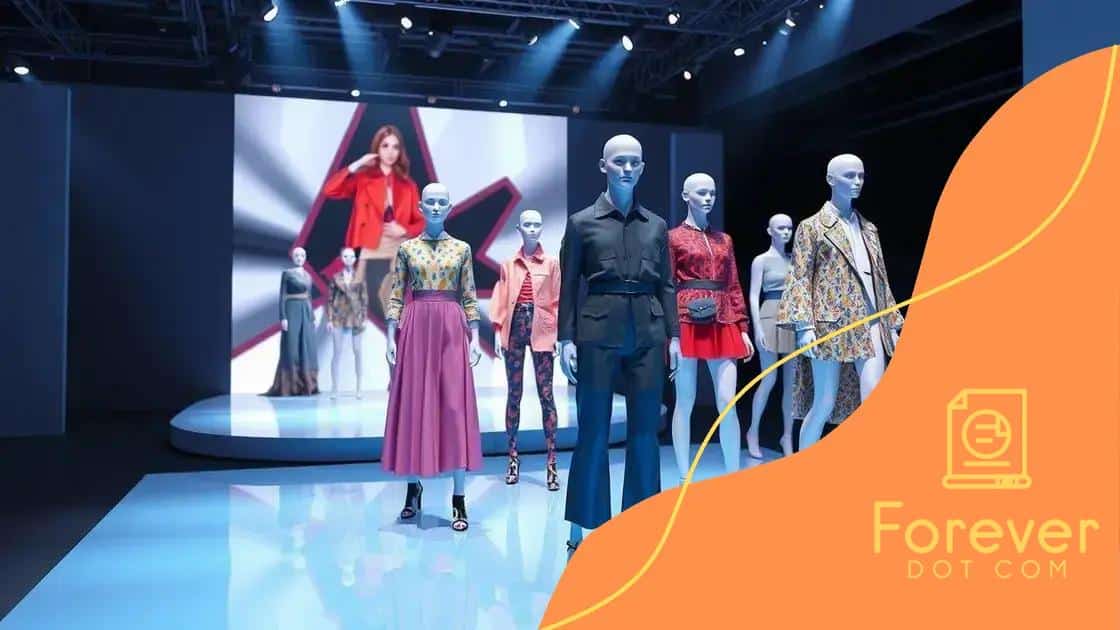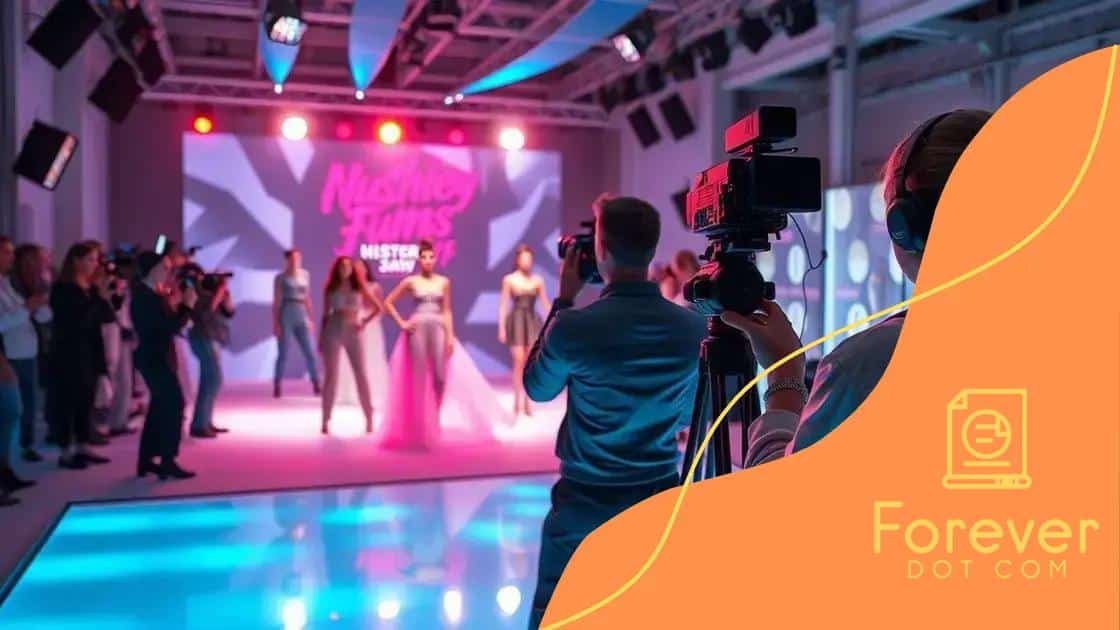Virtual fashion shows: The new runway era

Virtual fashion shows revolutionize runway presentations by providing a sustainable, accessible, and interactive platform for designers to showcase their collections globally, enhancing audience engagement through technology.
Virtual fashion shows are changing the game in the fashion industry. Imagine enjoying the latest collections from the comfort of your home, with an immersive experience that traditional shows just can’t match. Intrigued? Let’s dive in.
The rise of virtual fashion shows
In recent years, virtual fashion shows have emerged as a thrilling alternative to traditional runway events. These shows allow designers to showcase their collections in innovative ways, leveraging technology to create experiences that engage a global audience.
The Evolution of Fashion Shows
The journey from physical to virtual formats has been transformative. The shift began as a necessity during challenging times but evolved into a captivating opportunity for brands.
Benefits of Virtual Fashion Shows
There are several advantages to this new format that contribute to its growing popularity:
- Increased Accessibility: Anyone can attend from anywhere.
- Creative Freedom: Designers can experiment with digital landscapes.
- Wider Reach: Brands can connect with diverse audiences worldwide.
Virtual fashion shows not only democratize access to fashion but also challenge the traditional norms of showcasing clothing. They allow for unique storytelling through visuals, music, and animations that weren’t possible before.
How Technology Plays a Role
Innovative technologies such as augmented reality (AR) and virtual reality (VR) enhance the viewer’s experience. These tools can create immersive environments where viewers feel as if they are walking alongside models on the runway.
As the fashion world embraces these advancements, it opens the door for collaborations across industries, bringing together tech and fashion in an unprecedented way.
This merging fosters creativity, leading to shows that are not only visually stunning but also memorable for audiences. With every season, expectations rise, pushing designers to redefine what a fashion show can be.
Future Trends
Looking ahead, the landscape of virtual fashion shows will continue to evolve. Key trends to watch for include:
- Interactive Features: Viewers may influence show elements live.
- Integration with E-commerce: Shopping directly from the show experience.
- Environmental Considerations: Sustainable practices in digital formats.
As virtual fashion shows rise, they will shape the industry’s future, opening up new avenues for creativity, collaboration, and consumer engagement. Fashion will never be the same again.
Benefits of attending virtual shows
Attending virtual fashion shows comes with a host of benefits that make this new experience stand out from traditional runway events. It’s more than just a trend; it’s a shift that offers unique advantages for both viewers and designers alike.
Accessibility for Everyone
One of the most significant benefits is the increased accessibility. Everyone can join from anywhere in the world as long as they have an internet connection. This opens up fashion to audiences who might not have had the chance to attend physical shows.
Cost-Effective Experience
Virtual shows also eliminate many costs associated with attending in-person events, like travel and accommodation expenses. You can enjoy runway presentations right from your sofa, making it a more affordable option.
- No travel expenses: Save money by attending online.
- Inclusive participation: Everyone can join regardless of location.
- Easy access: Watch shows on multiple devices.
Not only can viewers enjoy the shows more easily, but designers can also reach a broader audience. This creates an opportunity for brands to showcase their creations without the limitations of physical venues.
Creative Engagement
The virtual format allows for creative storytelling and innovative presentations that are hard to replicate on a traditional runway. Designers can incorporate multimedia elements, making the experience immersive and interactive.
For attendees, this means more engaging content that captures their attention. They can interact with designers and brands in real-time, asking questions and giving feedback, which enhances the overall experience.
Environmentally Friendly
Additionally, virtual shows have a reduced environmental impact. With no travel and less waste from physical setups, they contribute to more sustainable practices in the fashion industry.
The benefits of attending virtual fashion shows are reshaping the industry. From accessibility to sustainability, this format is paving a new way for how fashion is experienced and enjoyed by all.
How virtual fashion shows are produced

Producing virtual fashion shows involves a unique blend of creativity and technology. This process can be quite different from traditional fashion shows, offering a fresh approach to presenting designs to the world.
Pre-Production Planning
The first step in creating a virtual show is planning. Designers must consider their overall vision and message. This includes deciding on themes, color palettes, and how to best showcase their collections digitally.
Choosing the Right Technology
Technology plays a vital role in the production of these shows. Brands often use high-quality video streaming platforms to ensure a smooth viewing experience. Essential elements include:
- Video quality: High-definition visuals are crucial.
- Interactive features: Tools that allow viewers to engage, like chats or polls.
- Augmented reality: Enhancing the experience with AR elements to visualize clothing.
Once the technology is in place, teams collaborate to create a storyboard for the show, mapping out how each piece will be presented.
Filming the Show
During filming, models often wear the designer’s pieces while digital backdrops or animations enhance their presence. This creative environment allows for artistic shots that bring garments to life in ways traditional runways can’t.
Multiple camera angles and editing techniques are used to provide viewers with an immersive experience. The goal is to make everything feel fluid and engaging.
Post-Production Magic
After filming, the editing process begins. This stage is crucial for polishing the final product. Editors will add effects, synchronize audio, and ensure transitions are smooth. All elements must align to create a compelling narrative that resonates with the audience.
Finally, the completed show is shared across various online platforms, making it accessible to viewers worldwide. This aspect of virtual fashion shows exemplifies how technology can widen the reach of fashion, bringing it to a global audience.
Impact on sustainability in fashion
The impact of virtual fashion shows on sustainability is a hot topic in the fashion industry. As brands and designers look for ways to reduce their environmental footprint, these shows present a unique opportunity to make fashion more eco-friendly.
Reducing Waste
One major benefit of virtual events is the significant reduction in waste associated with traditional fashion shows. Physical runways require elaborate sets, materials, and resources that often end up in landfills. In contrast, virtual shows streamline this by cutting out unnecessary physical components.
Lower Carbon Footprint
The transportation of models, supplies, and guests contributes greatly to carbon emissions. Virtual fashion shows eliminate the need for travel, allowing designers to reach global audiences without the associated environmental costs.
By going digital, brands can showcase their latest collections in a way that is less harmful to the planet. This move aligns fashion with growing consumer demand for sustainability.
Showcasing Sustainable Practices
Moreover, these shows can highlight sustainable practices directly. Designers can focus on eco-friendly materials and processes, communicating their commitment to sustainability effectively in a virtual format. Online viewers can engage with behind-the-scenes content, learning more about how their favorite brands are improving their practices.
- Eco-friendly materials: Highlighting the use of organic fabrics.
- Transparent practices: Educating consumers about sustainable methods.
- Innovative designs: Showcasing garments made to last.
As the fashion industry continues to evolve, the shift towards virtual shows signals a broader commitment to responsible consumption. This new normal allows brands to connect with consumers who care about environmental impact and sustainability.
The future of runway presentations
The future of runway presentations is being shaped by technology and evolving consumer expectations. As the fashion industry adapts, virtual shows are likely to play a bigger role in how designs are showcased to the public.
Integration of Technology
Advancements in technology are transforming how fashion is experienced. Augmented reality (AR) and virtual reality (VR) are at the forefront, bringing interactive elements into presentations. For instance, viewers could see clothing items in 3D and even try them on virtually.
Changing Audience Engagement
Engagement is becoming more interactive, allowing audiences to participate directly. Live chats during shows can enable viewers to ask questions and get instant feedback from designers. This creates a more personal connection between brands and consumers.
In addition, social media platforms will continue to influence how shows are marketed and shared. This means that fashion brands can quickly reach a global audience, making runway presentations more accessible than ever.
- Real-time interaction: Viewers can engage during the show.
- Wider audience reach: Shows can be streamed globally.
- Community building: Brands can connect with fans through social media.
As a result, traditional barriers in fashion are being dismantled. Emerging designers now have the opportunity to showcase their work on the same stage as more established brands, broadening the diversity in fashion.
Emergence of Hybrid Shows
The future may also see a rise in hybrid shows that combine in-person and virtual elements. This setup would give live audiences the experience of being at a physical location while engaging with a larger online audience simultaneously.
This blend not only enhances the spectacle but also creates greater opportunities for brands to tell their stories. With innovative production techniques, the runway can be an immersive experience that captivates audiences around the world.
The evolution of runway presentations reflects broader trends in society, with a focus on sustainability, accessibility, and innovation. As these changes take place, the fashion world will continue to adapt, ensuring that it keeps pace with the demands of modern consumers.
In conclusion, the world of virtual fashion shows is rapidly evolving, transforming how we experience runway presentations. As technology advances, it introduces new ways for brands to engage with their audiences. These shows not only reduce waste and carbon footprints but also make fashion more accessible to everyone. The integration of innovative tools like augmented and virtual reality enhances the viewer’s experience and tells compelling stories. As the industry looks to the future, the blend of traditional and virtual formats will likely pave the way for more inclusive and sustainable fashion practices. This exciting shift ensures that fashion continues to inspire and connect with people worldwide.
FAQ – Frequently Asked Questions about Virtual Fashion Shows
What are virtual fashion shows?
Virtual fashion shows are online presentations where designers showcase their latest collections using technology, allowing global audiences to view them from anywhere.
How do virtual fashion shows impact sustainability?
They significantly reduce waste and carbon footprints by eliminating the need for physical sets and travel, making fashion more eco-friendly.
What technologies are involved in virtual fashion shows?
Augmented reality (AR) and virtual reality (VR) are commonly used to enhance viewer experiences, allowing for interactive and immersive presentations.
How do virtual shows enhance audience engagement?
Virtual shows enable real-time interactions, where viewers can ask questions and engage with brands directly during the presentation, fostering a closer connection.






